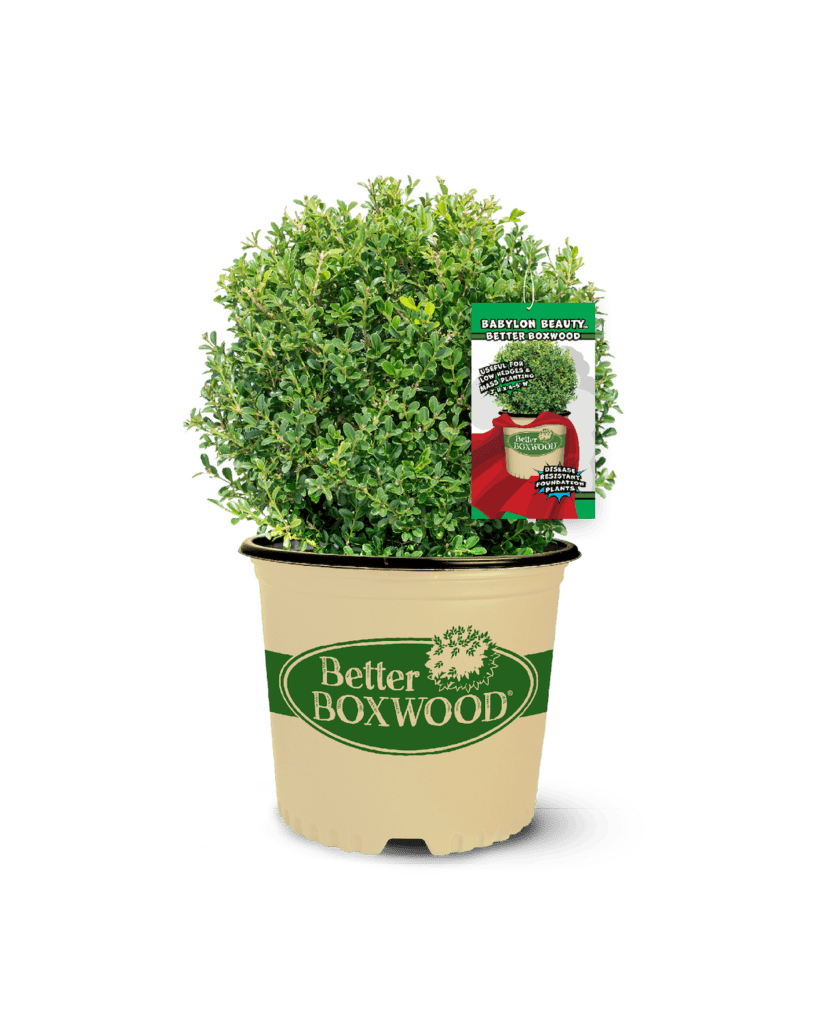
Babylon Beauty™
Buxus Hybrid ‘HER2010B04’ PP32273
This compact variety features a growth habit that spreads wider than it is tall, making it an ideal choice for low-growing hedges, mass plantings, foundation plantings, and patio containers. With its lighter green foliage, Babylon Beauty maintains its evergreen vibrancy throughout the year, providing year-round beauty with minimal upkeep. Its adaptability makes it perfect for both formal and casual garden settings. Sustainably bred to resist boxwood blight and common pests.
Versatile Mass Planting.
Hardiness: Hardy in USDA zones 5–9
Size: 3’ high x 4–5’ wide
Best Uses: Bed, Border, Mass Planting, Foundation, Container
Growth Habit
Babylon Beauty has a low spreading growth if not pruned, which makes it an excellent mass planting option.
Best Uses
Ideal for layering applications, public green spaces, and as a mass planting. Its spreading habit and robust root system make it adaptable to a variety of soil conditions and landscaping needs.
Root Strength
Babylon Beauty’s strong roots make it suitable for poorer soils, offering versatility in various planting conditions.
Planting & Care Tips for Babylon Beauty™ Boxwood
Here’s how to plant and care for Better Boxwood Babylon Beauty™:
1. Choosing the Right Location
Better Boxwood Babylon Beauty™ thrives in USDA zones 5-9 and prefers well-drained soil to keep its roots healthy. Although boxwoods are adaptable to a variety of soil conditions—ranging from acidic to alkaline, and from clay to sandy loam—good drainage is helpful.
When selecting a planting location, choose one that provides partial shade to dappled sunlight. Boxwoods can also tolerate full sun, but in hotter climates, they benefit from afternoon shade to avoid heat stress. Ideally, this plant thrives with 4-6 hours of direct morning light. If planted in heavy shade, Babylon Beauty™ may exhibit a more open, less dense form. To avoid winter damage, plant in an area protected from strong winter winds.
2. Planting Instructions
When planting Better Boxwood Babylon Beauty™, space the shrubs about 3-4 feet apart. This spacing allows the plant to grow into its natural form, which reaches 3 feet in height and 4-5 feet in width. Before planting, prepare the soil by digging a hole that’s twice as wide and the same depth as the root ball. This allows the roots to spread easily and become established.
Once planted, backfill the hole with soil and water thoroughly. Applying mulch around the base of the shrub helps retain moisture and regulate soil temperature. Make sure to leave space around the stem to avoid moisture buildup, which can cause rot.
3. Watering and Fertilization
Babylon Beauty™ requires regular watering during its first year to establish strong roots. Water deeply once a week or more frequently if the weather is hot and dry. Once the shrub is established, reduce watering to a maintenance schedule that keeps the soil evenly moist but not waterlogged.
Boxwoods benefit from annual fertilization in early spring to encourage healthy growth. Choose a balanced, slow-release fertilizer and follow the manufacturer’s instructions. Over-fertilizing can cause excessive growth, which can make the plant more susceptible to diseases.
4. Pruning and Maintenance
Better Boxwood Babylon Beauty™ has a naturally compact, rounded growth habit, which means minimal pruning is required. However, occasional trimming can help maintain its shape and promote denser foliage. Prune in late winter or early spring before new growth begins.
One of the key benefits of Babylon Beauty™ is its resistance to boxwood blight and other common pests, making it a low-maintenance option for gardeners who want a disease-resistant shrub. Its evergreen nature ensures year-round visual appeal with minimal upkeep.
5. Protecting Against Winter Damage
Like other broadleaf evergreens, boxwoods can suffer from winter damage due to exposure to wind and fluctuating temperatures. To minimize this, apply mulch around the plant’s base to insulate the roots. In colder climates, consider wrapping the shrub with burlap during the harshest months to protect it from windburn.
